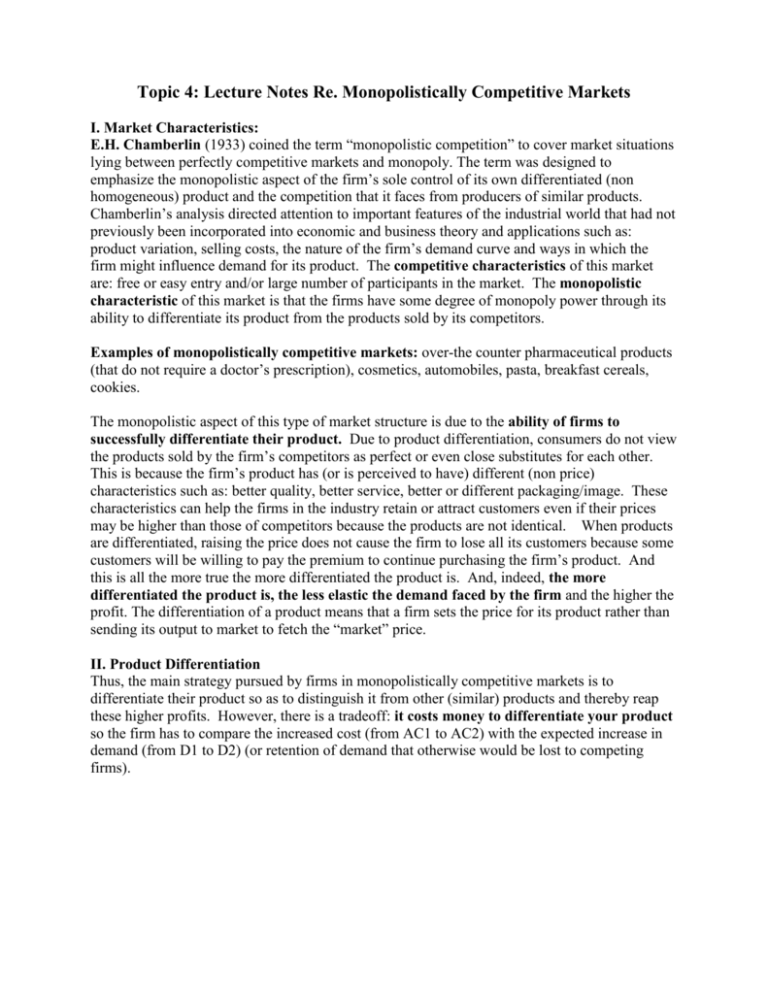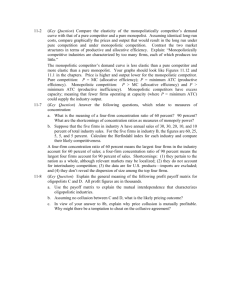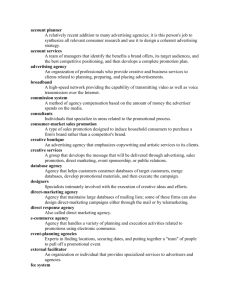
Topic 4: Lecture Notes Re. Monopolistically Competitive Markets
I. Market Characteristics:
E.H. Chamberlin (1933) coined the term “monopolistic competition” to cover market situations
lying between perfectly competitive markets and monopoly. The term was designed to
emphasize the monopolistic aspect of the firm’s sole control of its own differentiated (non
homogeneous) product and the competition that it faces from producers of similar products.
Chamberlin’s analysis directed attention to important features of the industrial world that had not
previously been incorporated into economic and business theory and applications such as:
product variation, selling costs, the nature of the firm’s demand curve and ways in which the
firm might influence demand for its product. The competitive characteristics of this market
are: free or easy entry and/or large number of participants in the market. The monopolistic
characteristic of this market is that the firms have some degree of monopoly power through its
ability to differentiate its product from the products sold by its competitors.
Examples of monopolistically competitive markets: over-the counter pharmaceutical products
(that do not require a doctor’s prescription), cosmetics, automobiles, pasta, breakfast cereals,
cookies.
The monopolistic aspect of this type of market structure is due to the ability of firms to
successfully differentiate their product. Due to product differentiation, consumers do not view
the products sold by the firm’s competitors as perfect or even close substitutes for each other.
This is because the firm’s product has (or is perceived to have) different (non price)
characteristics such as: better quality, better service, better or different packaging/image. These
characteristics can help the firms in the industry retain or attract customers even if their prices
may be higher than those of competitors because the products are not identical. When products
are differentiated, raising the price does not cause the firm to lose all its customers because some
customers will be willing to pay the premium to continue purchasing the firm’s product. And
this is all the more true the more differentiated the product is. And, indeed, the more
differentiated the product is, the less elastic the demand faced by the firm and the higher the
profit. The differentiation of a product means that a firm sets the price for its product rather than
sending its output to market to fetch the “market” price.
II. Product Differentiation
Thus, the main strategy pursued by firms in monopolistically competitive markets is to
differentiate their product so as to distinguish it from other (similar) products and thereby reap
these higher profits. However, there is a tradeoff: it costs money to differentiate your product
so the firm has to compare the increased cost (from AC1 to AC2) with the expected increase in
demand (from D1 to D2) (or retention of demand that otherwise would be lost to competing
firms).
$/Q
Scenario 1: Firm facing demand for its
product D1 and costs of production AC1
cannot make money in this market because
the market price will always be < its AC.
But if it invests in a product
differentiation/marketing strategy that will
increase its costs to AC2 but will also
increase demand to D2 then it may be able to
profitably operate in this market.
AC2
AC1
D2
D1
Q/t
$/Q
MC
AC2
P2
AC1
D2
P1
D1
Q/t
Q1
Q2
Scenario 2: Firm facing demand for its product
D1 and costs of production AC1 is charging the
profit maximizing price P1 and selling Q1 and
making a profit. (Note: the profit maximizing
price and quantity are chosen by equating
MC(Q) and MR(Q) as in the monopoly model).
It undertakes a new ad campaign which
increases its AC to AC2 (assume the MC
remains the same) but the campaign’s effect on
demand is less effective than it expected (or the
cost of the campaign is higher than expected),
increasing demand to D2 and resulting in losses.
for the firm.
How do you differentiate your product?
1. Product Characteristics: By giving your product characteristics that you think consumers
will like or prefer to those of your competitors. Economist Kelvin Lancaster was one of the
pioneers of the study of consumer preferences with regard to product characteristics. To study
how consumers form their preferences for products, Lancaster developed the theory of
characteristic space. He proposed that each product is viewed (by consumers) as a bundle of
characteristics. For example, candy is not just candy but a set of characteristics which include
sweetness, texture, calorie content content, crunchiness, durability. Sellers of candy will try
to develop types of candy that meet what they believe to be the characteristics that consumers
like and will use these characteristics to differentiate their candy from the candy sold by their
competitors. When we analyze products in this way, we view the product in terms of (1) its
characteristics and (2) where it falls in the “characteristic space”.
Example: Mars bar
Characteristics: sweetness, texture, durability, calories
Where it falls in the characteristic space:
Sweetness
low-------x--high
Texture
soft-x------hard
Durability
1 hr.------------x--2 years
Calories
low----------x-high
2. Marketing and Advertising: By trying to convince your customers and potential customers
that your product is better, more convenient, of better quality (e.g. the lemons problem), safer,
hipper, easier to use, easier to reach (location), easier to understand, more versatile, etc. A big
part of this effort involves marketing and advertising. Indeed many firms in monopolistically
competitive markets spend a large amount on advertising. See posted data re. top US advertisers.
Top advertisers (in terms of ad spending as % of sales) include many low price/margin, high
volume businesses such as lower end cosmetics, fast food, soft drinks, consumer household
products.
There are 2 main types of advertising:
(1) Informational advertising aimed at describing a product or services’ characteristics,
informing customers of special promotions, store locations, quality of the product, uses for the
product, etc.
(2) Persuasive advertising: aimed at altering consumers tastes, drawing them to the product,
drawing them away from competing products, communicating perceptions associated with the
product, etc. Sometimes this may involve advertising a product which is in many respects
identical to competing products (spurious product differentiation), e.g. Clorox Bleach.
Sometimes it is difficult to distinguish between the 2 types of advertising.
Some firms may also invest in advertising as a way of increasing the barriers to entry in their
market (e.g. Coke and Pepsi). They are basically signaling to their competitors the following
entry-deterring strategy: “if you want to enter this market, we are going to make it very costly for
you to do so.”
3. Branding: The most successful firms in monopolistically competitive markets seem to be
those that have succeeded in developing a “brand name”. Consumers seem to respond very well
to branding and are willing to pay more for brand name products (a lot more) than for competing
products (even when there is no difference in their content)
Examples: Bayer aspirin, Clorox bleach, Xerox copiers, Kleenex tissues, Benadryl allergy
medicine, Volvo cars.
Fighting brands: Variations of the brand product developed to compete with possible entry of
competitors into submarkets for the brand product.
Examples: VH1 developed by MTV to preempt entry into the older music video market;
CNN Headline News developed by CNN to preempt entry into the short format
international/national news market. Sometimes however, the fighting brand strategy is
considered illegal by the US Justice Dept. on the grounds that this strategy (also called defensive
branding or brand proliferation) is anticompetitive with the sole aim of covering the
characteristic space around the brand so as to prevent entry by other firms.
Example: 1972 FTC antitrust suit against the 4 largest cereal manufacturers of ready-to-eat
breakfast cereal for “brand proliferation”. Is Perfetti in Italy guilty of a similar strategy? Is it
anti-competitive under EU antitrust laws?
Why don’t generic or no-name brands advertise? After all, their products have largely the
same ingredients and are much cheaper. Because it would be expensive for them to do so to do
and would likely wipe out a substantial part of the cost differential. Also, some of the no-name
brands aren’t really no-name. They are the house brand of the distributor of the name brand
items, such as Walgreens, Shop Rite or Duane Read. If they advertise their own house brand too
much, they would be competing with the name brands with whom they have (lucrative)
distribution contracts.
The intended effect of product differentiation, marketing, advertising and branding is to:
(a) increase demand for the product (outward shift of the demand curve) or
(b) make the demand less elastic so that consumers are willing to buy more at higher prices.
The latter motivation is especially strong for firms with more market power because this will
increase their profitability. Recall the Lerner index expression for the profit-maximizing
monopoly pricing condition:
(P-MC)/P = - 1/e
Where P is the market price of the product, MC is the marginal cost of producing the product and
e is its elasticity of demand.
The price cost margin is inversely proportional to the elasticity of demand “e” implying that the
less elastic the demand is, the higher the ability of the monopolist to profitably price above
cost. Successful product differentiation/branding may allow the monopolistically competitive
firm to behave as a near-monopolist with regard to the pricing of its product.
4. Differentiation by location: Notice how firms that sell similar products tend to locate close to
each other? Gas stations, department stores, retail stores, fast food restaurants, etc. In 1929,
Harold Hotteling developed a location model to explain how firms make decisions about where
to locate. In the simplest location models firms sell the same homogeneous product and are
differentiated only by location so the closer the firms are to each other the closer substitutes they
are for each other’s products. Suppose there is a city with only one narrow street and the
people who live in the city are uniformly distributed along the street. Suppose that there are 2
stores in the city that sell milk and consumers have no preference for one store over the other
except that they prefer to travel a shorter distance to buy the milk (i.e. they incur transportation
costs).
Where should the 2 stores locate? Suppose that store 2 is already located at distance b from
the end of town. Then, where should store 1 locate? Store 1 will locate just to the left of store 2
because that way he will capture all of the customers to his left. Now, what if store 2 could
costlessly relocate? It would locate slightly to the left of store 1. This would continue until both
stores were located in the center of town next to each other and each serving half of the people in
town, to the left and to the right of their respective locations. This is the equilibrium outcome =
Nash in location strategies because given these locations no firm wants to change its location.
x---------------------------------------------------I-I-------------------------------------------------b--------x
Store 1 Store 2
Initial location store 1
Examples of the clustering phenomenon: diamond district in NY, fabric district, flower
districts in cities, gas stations near each other, Hollywood, Silicone Valley.
Explanations for this phenomenon: reduced cost to potential consumers from being able to
travel to a single location to shop, economies of scale associated with lower transportation and
other services costs for companies in the same business being located close to each other; better
availability of specialized labor; benefits associated with advertising by one of the firms in the
clustered area. These aspects of the clustering phenomenon seem to outweigh the costs
associated with being in the midst of your closest competitors.
III. Welfare Implications of Monopolistically Competitive Markets:
Is the monopolistically competitive market structure better for society than the perfectly
competitive market structure? Price will be higher in monopolistically competitive markets but
there will be more variety, which may be a good thing. Therefore there is a trade off. On the
other hand, firms may be driven to invest in excessive or misleading advertising and some of the
resulting “variety” may be wasteful from society’s point of view. It is clear that in most cases
advertising benefits sellers. Is advertising good or bad for consumers? Informational advertising
can be beneficial for consumers (as long as it is not misleading.) Also, in markets in which
information is unavailable or costly, advertising (e.g. re. the relative quality of the product) may
increase consumer welfare. Advertising may lead to a better match between consumers and
products in the case of differentiated products (e.g. choose the cellular phone plan that best
matches your usage.) If, on the other hand, products are essentially identical, advertising simply
shifts demand from one firm to another which may be socially wasteful.
IV. Appendix: (optional)
In the most basic model of monopolistic competition we assume that:
(a) the firm behaves as a monopolist relative to the estimated demand for its product: it
chooses output Q such that MR(Q) = MC(Q)
(b) firms assume that a change in the price they charge will not affect the pricing decisions
of other firms.
Note: The price of a given product exerts a greater constraint on another’ product’s pricing (that
is, the firm will tend to lose sales if it prices above the competing firm’s price) when the two
products are close substitutes (i.e. undifferentiated) than when they are not.
Pricing Differences in Markets with Undifferentiated versus Differentiated Products1:
When products are undifferentiated, consumers will be unwilling to pay more for a given
firm’s product than for another’s. Therefore, there will be a single market price P and the
demand facing a particular firm depends only on the TOTAL supply of the other firms in the
market.
That is, if there are n firms in the market, the market price P will be determined by the inverse
demand function:
P = D(Q1, Q2,……Qn) where Q = Q1+ Q2 + ….Qn.
Example: Suppose there are 2 firms in an industry who both sell an undifferentiated
product. Then market demand can be described by the inverse demand function:
P = a-bQ
Since there are 2 firms in the industry, Q = Q1+Q2. Thus,
P = a – b (Q1 + Q2)
P = a – bQ1 – bQ2
This indicates that an increase in either firm’s level of output Q1 or Q2 will cause a decline in
the market price.
1
Parts of this section are taken from: Dennis W. Carlton and Jeffrey M. Perloff, Modern Industrial Organization,
further edition, 2005, Pearson Addison Wesley, Chapter 7, Product Differentiation and Monopolistic Competition.
However, if the firms’ products are differentiated (i.e. consumers do not view them as perfect
substitutes for each other), then there need not be a single market price P but two market prices
P1 and P2. Then, firm 1’s demand curve will be:
P1 = a – b1Q1 – b2Q2 where b1 > b2
That is, an increase in firm 1’s output will have a greater effect on the price charged by firm 1
than an increase in firm 2’s output. In fact, the more successful firm 1 is in differentiating its
product, the less affected it will be by the actions of the other firm. Thus, the more
differentiated firm 1’s product, the smaller b2 will be, i.e. the less it will affect firm 1’s price
P1.
Example: firm 1 sells very high quality wine. Firm 2 sells very inexpensive and lower quality
wine. The amount of wine sold by firm 2 (Q2) and the price charged by firm (P2) may have very
little effect on firm 1’s price (P1).










